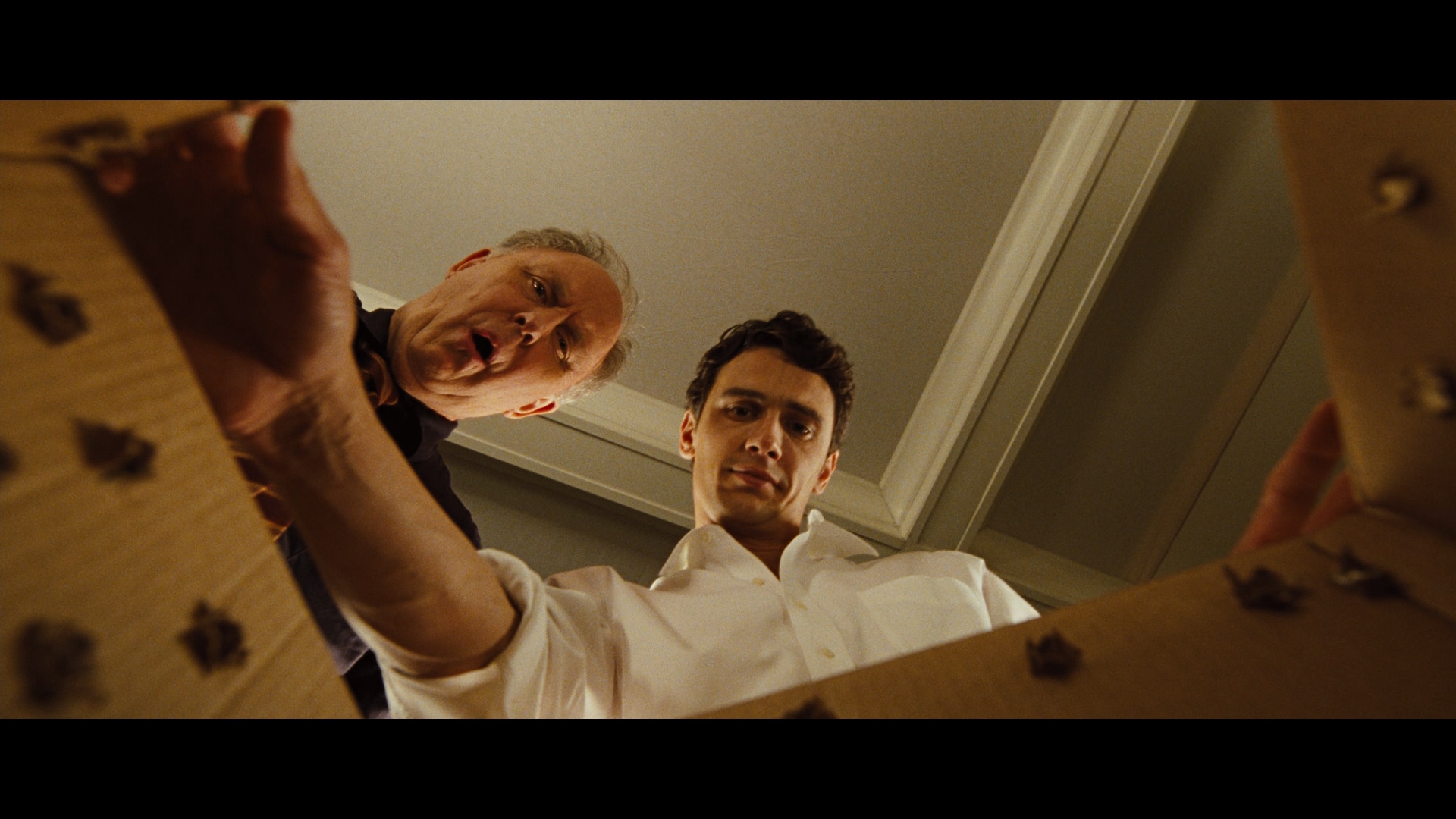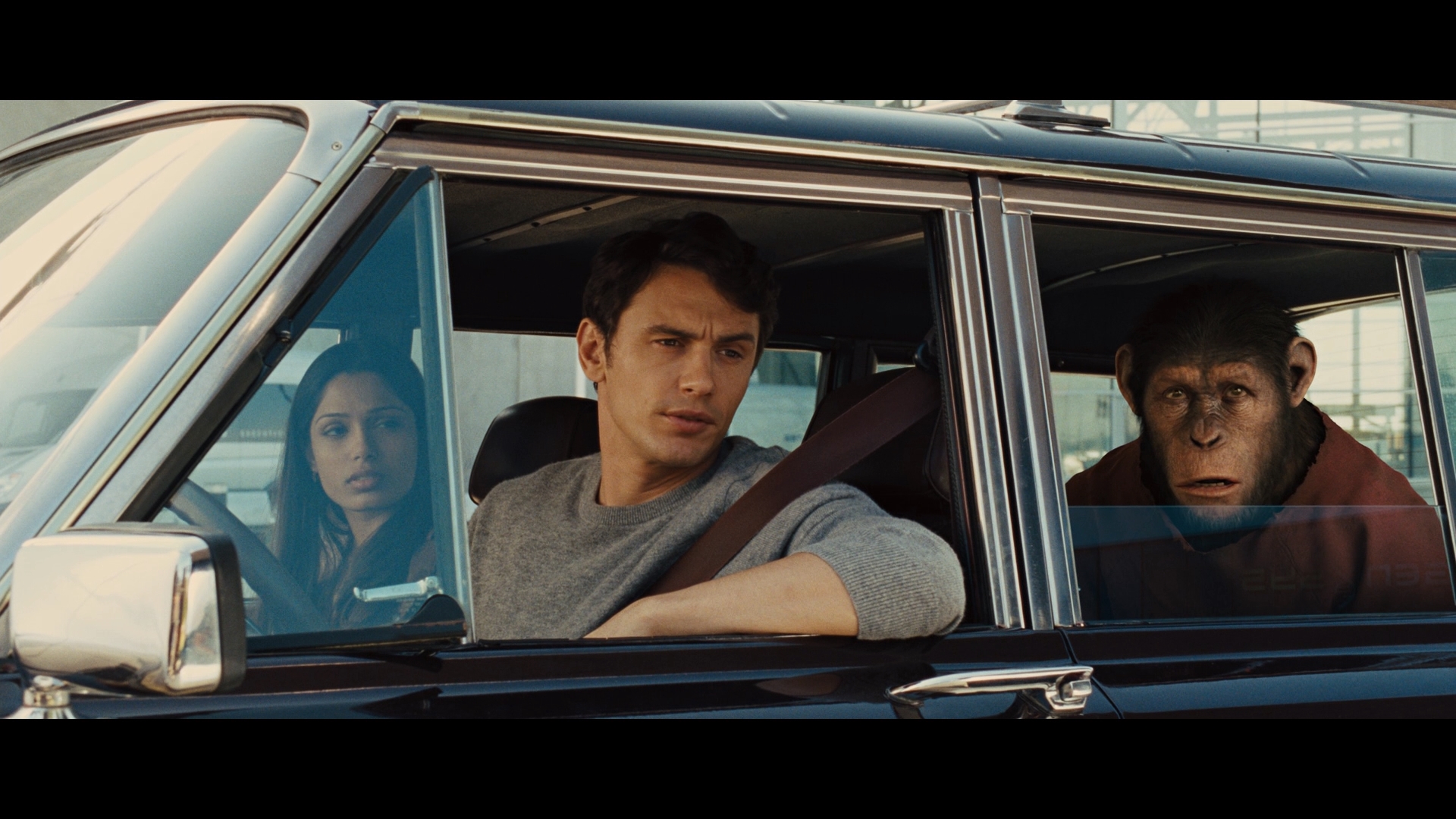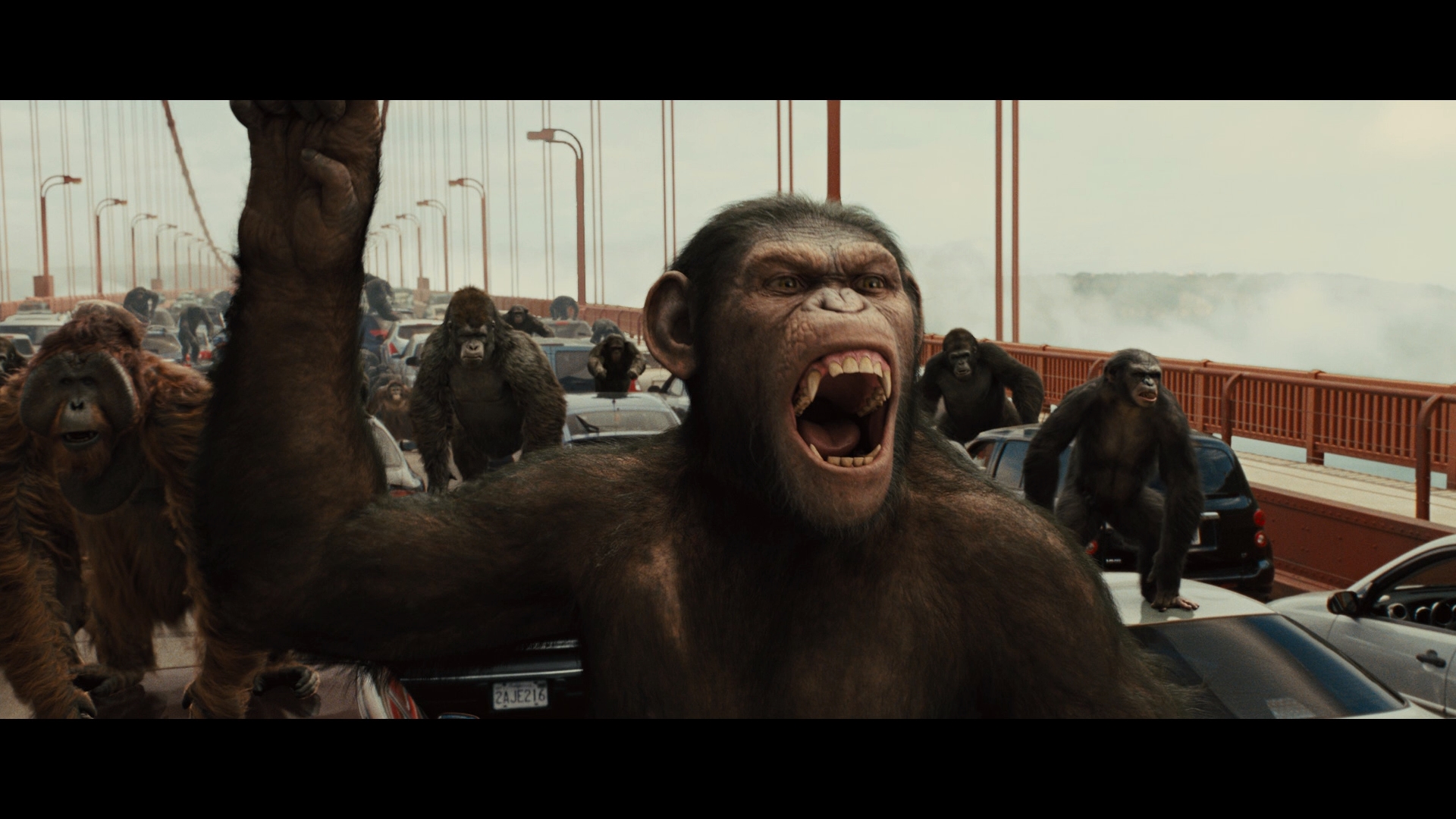| Reviews & Columns |
|
Reviews DVD TV on DVD Blu-ray 4K UHD International DVDs In Theaters Reviews by Studio Video Games Features Collector Series DVDs Easter Egg Database Interviews DVD Talk Radio Feature Articles Columns Anime Talk DVD Savant Horror DVDs The M.O.D. Squad Art House HD Talk Silent DVD
|
DVD Talk Forum |
|
|
| Resources |
|
DVD Price Search Customer Service #'s RCE Info Links |
|
Columns
|
|
|
Rise Of The Planet Of The Apes

Rise of the Planet of the Apes is now known as the first movie in a series of hit films (the third arriving in theaters the week I write this review) reviving one of 20th Century Fox's most popular franchises. What many have forgotten, however, is what a big surprise this movie was when it first hit theaters back in 2011. Fox hasn't had a great track record when it comes to trying to revive/reboot popular brands of which they have creative control (look at the continuing failed attempts with both the Alien and Predator movies), so when the word got out that they were attempting to re-launch Planet of the Apes again (after the disappointing Tim Burton film, most didn't expect much. But, alas, Rise of the Planet of the Apes is a great rekindling of the franchise. It re-imagines the Apes universe without feeling the need to repeat it, covering new ground while throwing enough original series nods and "easter eggs" into the mix to appeal to loyal fans.
The movie stars James Franco as Dr. Will Rodman, a scientist who is using apes to drug test a chemical in the hopes of finding a cure to Alzheimer's. When the latest strain of the drug seems to work wonders on the mental capabilities of a chimpanzee, Rodman takes his findings to the company's board of directors to get approval for human testing. However, the chimp in question breaks out of her cage and goes on a rampage, causing her to have to be put down by the staff and leading to the board's rejection of any further testing. It turns out that the chimp was only protecting her newborn baby - whom Will takes home after the order is given to put down all the other apes at the facility.
Will names the chimp Caesar and soon learns that the drug he used on Caesar's mother has been passed on to her offspring. Caesar shows a remarkable growth in intelligence and begins to learn at an exponential rate - using sign language to communicate. Viewers also learn Will's obsession with getting approval for the drug he was testing at the lab: Will's father, Charles (John Lithgow), has advanced Alzheimer's himself and when it seems like his disease is beyond the point where Will can take care of his father anymore, he steals some of the drug and injects his dad with it. The next day, Charles is back to normal and - to Will's surprise - he actually seems to be more intelligent than he's ever been, even when he didn't have Alzheimer's.
Years pass and Will notes that his father's system is building up antibodies to the drug and he's starting to lapse. Before he can address working on a stronger drug, Caesar gets into trouble when he attacks a neighbor for yelling at Charles when Charles inadvertently tries to drive off in the neighbor's car. The incident is violent enough (Caesar actually bites off the neighbor's finger) to get the chimpanzee sent to a local facility where normal apes are kept but treated brutally by one of the workers there, named Dodge (Tom Felton). It isn't long before Caesar is plotting his escape...including plans to free all the other apes as well.
The biggest technical leap this movie takes over its predecessors is the use of motion-capture and CGI for the ape performances. Actor Andy Serkis (best known before this movie's release for his motion-capture work as Gollum in the Lord of the Rings movies) performs Caesar here, and one need only check out the bonus materials on this release to see just how much of the CGI Caesar we see in the movie is a mirror of Serkis's performance. Despite the fact that the apes are computer creations (the F/X work is good overall, but there are a number of shots where the illusion isn't as natural looking), the movie still proves to be the most "realistic" Apes film to date (not counting the sequels to this movie, of course), nixing the ol' actors in suits concept - which was something audiences were certainly used to but, let's be honest, never really looked like actual apes.
While Rise of the Planet of the Apes isn't quite a great movie, it's an entertaining one and proved to be a great first step in what's turned out to be a fun new exploration of these characters and this concept. How long the studio will be able to keep this franchise afloat before things start getting uninteresting again is anyone's guess, but so far they've been smart enough to take their time to getting to the point where the original Charlton Heston movie intersects with these characters. For now though, I'm really enjoying this cinematic ride, and this film is the first step in a bold new direction.
The Blu-Ray Packaging
Rise of the Planet of the Apes breaks loose onto 4K in this Ultra HD/Blu-ray/Digital HD combo pack. The 4K and 50GB Blu-ray arrive housed inside an eco-friendly black Elite keepcase along with two inserts: one with a code for a digital copy of the movie (sadly, only in 1080p, not UHD) and the other containing a second code for a sneak preview of the new War for the Planet of the Apes movie. A slipcover with artwork matching that of the keepcase's slick slides overtop. There are no front-loaded trailers on the 4K disc; however, the Blu-ray is front-loaded with trailers for The Sitter and In Time. Both the Ultra HD menu and the Blu-ray menu have a similar design, with a montage of footage from the film and menu selections horizontally across the bottom of the screen.
The Blu-ray is in this release is Region A locked, and the Ultra HD disc (as is the case with all such releases) has no region coding.
The Video
Rise of the Planet of the Apes was shot on film using Arricam LT and Arriflex 435 cameras and is presented in the 2.35:1 aspect ratio. The 4K image here is an up-convert from a 2K Digital Intermediate, and although it isn't "True" 4K, it still looks pretty good. The biggest problem here is while the HDR (High Dynamic Range) adds some deep greens, bright yellows, and dark reds to the presentation, in terms of overall detail, the 4K transfer isn't leaps and bounds better than the 1080p Blu-ray version. That's not a knock on the 4K disc as much as it is a recognition that the original Blu-ray release (the same 2011 release is the Blu-ray included here) had/has a pretty outstanding transfer. Make no mistake though, the level of detail in the 4K image is noticeable compared to its 1080p counterpart.
Another slight downside for the 4K image is that the increase in detail also means the special effects are much more apparent. While much of the CGI work in Rise of the Planet of the Apes is impressive, other shots (usually when there are a bunch of apes moving in one scene) are a little less impressive and during those moments it's obvious to the viewer that he/she is watching computer-rendered creatures as opposed to the illusion of the real thing.
As for other aspects of the transfer, black levels are nice and deep throughout and there are no problems with any obvious glitches, such as aliasing or banding. Flesh tones are slightly inconsistent from scene to scene, but nothing too distracting.
The Audio
The featured audio option here is an English 5.1 DTS-HD Master Audio track, which means that - no - 20th Century Fox didn't opt for an Atmos update of the soundtrack, which may be disappointing to some/most that have Atmos set-ups at home (this reviewer does not, so I was less upset). While a 5.1 track certainly presents some limitations for those with primo home theaters, as far as 5.1 renderings go, this is about as good as it gets. There's a wonderful feeling of immersion in many scenes - particularly scenes that take place out in jungle or forest areas, and specifically during the movie's climax on the Golden Gate bridge. I was especially impressed with how the track makes use of LFE (that's the low-end sound that comes through one's subwoofer) via the roar of various apes.
The mix here is nicely done - so no problems with the musical soundtrack and ambient noises drowning out the spoken word (the dialogue is primarily front and center throughout the movie). Overall, this audio presentation adds an additional layer of entertainment to one's enjoyment of the film. It's reference-quality for 5.1 lossless audio, and the only reason I didn't give it perfect marks here is because it's only 5.1 (as opposed to Atmos or even 7.1), which is rare for most 4K titles to date. Otherwise, it's hard to complain.
In addition to the lossless English 5.1 track, 5.1 DTS tracks are available in French, Spanish (Castilian), German, and Italian, as is a Spanish (Latin) track in 5.1 Dolby Digital. There's also an English Descriptive Audio track in Dolby Digital 5.1. Subtitles are an option in English SDH, Spanish (Latin), Spanish (Castilian), French, German, Italian, Cantonese, Danish, Dutch, Finnish, Mandarin (Traditional), Mandarin (Simplified), Swedish, and Norwegian.

The Extras
Ultra 4K Disc
- Audio Commentary with Rupert Wyatt - The director of the film gives a somewhat dry and occasionally technical description of his movie. While the track is worth a listen, it's not that engaging, with Wyatt taking too many pauses and often only re-describing what viewers are seeing on screen. Subtitles for this commentary are available in English, Spanish (Latin), Spanish (Castilian), French, German, and Italian. (Note: This commentary track is also available on the Blu-ray disc.)
- Audio Commentary with Rick Jaffa and Amanda Silver - The writers of the movie provide a much more entertaining commentary than the director's track, talking about their ideas for the story and pointing out various things viewers may have missed. Subtitles for this commentary are available in English, Spanish (Latin), Spanish (Castilian), French, German, and Italian. (Note: This commentary track is also available on the Blu-ray disc.)
Blu-ray Disc
- Deleted Scenes (HD, 12:00) - A collection of 11 deleted scenes from the movie, which can be watched individually or all together. The best part of these deleted moments is that most of them are unfinished, meaning instead of seeing the CGI Caesar, viewers often get to see Andy Serkis acting in his motion-capture suit, which shows just how much his performance is part of the character. They consist of: "Alpha Gets Shot" (0:40), "Will's Meeting with Lab Assistants" (1:11), "Will Discovers Caesar Has Solved Puzzles" (1:58), "Caesar Plays with Bicycle" (1:02), "Caesar Questions His Identity" (1:16), "Caesar Bites Off Neighbor's Finger" (0:27), "Rodney Gives Caesar a Cookie" (1:16), "Rocket Gets Hosed by Dodge" (0:40), "Caesar Destroys the Lab and Koba's Attempted Revenge on Jacobs" (1:25), "Caesar Pushes Helicopter" (0:44), and "Koba with Shotgun" (0:58).
- Mythology of the Apes (HD, 7:11) - A look at the history of the Planet of the Apes movies as well as a look at the development and making of this reboot/re-imagining, including "Easter Eggs" that were put into the new film for fans of the originals. Included here are comments from the cast and crew.
- The Genius of Andy Serkis (HD, 7:48) - A closer look at the motion-capture performance of Andy Serkis as Caesar, including comments from Serkis himself, as well as other members of the cast and crew.
- A New Generation of Apes (HD, 9:41) - This featurette talks about how the apes got a modern-day update for this new re-telling of the story, focusing primarily the actors learning how to do their motion-capture performances and how the effects team then turned those performances into CGI realistic-looking apes. Included here are comments from Director Rupert Wyatt, as well as other members of the crew.
- Scene Breakdown (HD, 1:34) - This interactive bonus feature allows viewers to look at a scene from the movie (Caesar giving chocolate chip cookies to the other apes) and use the color-coded buttons on their remote controls to flip between the motion-capture performance, the early animation, and the final version we see in the movie.
- Character Concept Art Gallery - This slide show of images shows a photo of six ape characters in the movie. Using one's remote control, viewers can click on each ape to see a larger version of their concept art and then click right to see the final movie version of that character.
- Breaking Motion Capture Boundaries (HD, 8:43) - This segment takes a look at the big action sequence on the Golden Gate bridge (no they didn't shoot it on the real one) that climaxes the movie, focusing on both the stunt work and the motion-capture work of the stunt team. Once again, we get plenty of comments from various members of the crew.
- Composing the Score with Patrick Doyle (HD, 8:07) - The movie's composer talks about his various pieces for the movie's soundtrack and the ideas he wanted to present for each of them.
- The Great Apes (HD, 22:37) - This can be officially labeled the "educational" part of this disc, as these three segments (which can be viewed together or individually, and start with a rotating 3D look at a film character that represents the species, with facts showing up on the right side of the screen) tell us more about the following ape species: Chimpanzee (6:06), Gorilla (6:52), and Orangutan (7:00).
- Theatrical Trailers (6:29) - Three theatrical trailers for Rise of the Planet of the Apes, which can be played together or individually.

Final Thoughts
A pleasant surprise when it hit theaters back in 2011, Rise of the Planet of the Apes still holds up as one of the few reboots/relaunches (and, yes, technically even a prequel) that doesn't dishonor the original movie upon which it is based. No, perhaps it's not as powerful as the original Planet of the Apes, but that was something fresh and new. Few will go into this film (or any of its sequels) not knowing the fate of humanity. That the filmmakers can still take a story where most viewers know the final outcome and still make it exciting and engaging is a real achievement. The only caveat about this release is that the 4K image isn't a significant jump over the prior Blu-ray (also included here) and there are no new bonus materials. Still, assuming you don't own the prior 1080p release, this 4K version is Recommended.
|
| Popular Reviews |
| Sponsored Links |
|
|
| Sponsored Links |
|
|
| Release List | Reviews | Shop | Newsletter | Forum | DVD Giveaways | Blu-Ray | Advertise |
|
Copyright 2024 DVDTalk.com All Rights Reserved. Legal Info, Privacy Policy, Terms of Use,
Manage Preferences,
Your Privacy Choices | |||||||













